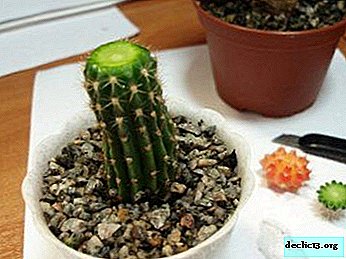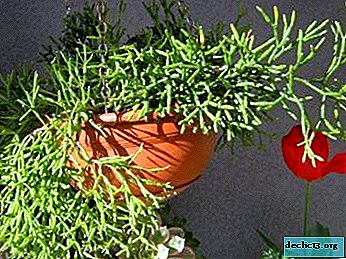All about the need and proper technique for pruning a cactus

Cacti are extremely unpretentious in care and can grow on almost any windowsill, without requiring close attention.
But sometimes there is a need for a cactus transplant. If the cactus is twisted, withers and refuses to bloom, it is necessary to prune it. This will help save the plant from disease and overgrowth.
This article describes in detail the entire technology for the correct pruning of a cactus. Presents the types of cacti, which are most often subjected to the pruning process.
Can this be done?
Cactus pruning is possible, and in some cases simply necessary.
Cactus can be cut and re-rooted for various reasons, but most often this happens when it is necessary:
- The plant begins to rot.
- The shape is changing, the plant is very skewed.
- Strongly grown and extended.
Cacti get sick due to inept care, pests or inappropriate treatment. Warm wintering, excessive watering or lack of light can seriously weaken the plant, reduce its ability to resist diseases and pests. To prevent this from happening, we suggest reading about how to properly water this plant and which place is better to choose to accommodate a green friend.
Rotting may begin due to:
- Overflow.
- Unsuitable soil (all details on soil selection can be found here).
- Too big pot in which water stagnates (how to choose a pot for a cactus?).
- Due to fungal and bacterial infections.
Which species are most needed?
What types of cacti require pruning most often? Most often you have to cut the plants of the following varieties:
Gimnokalitsium Mikhanovich

Has a thick elongated stem covered with triangular ribs, has a brown or grayish-green color.
Echinocactus

A spherical plant, slowly growing, unpretentious.
Kleistocactus Strauss

Horizontal columnar plant, grows up to 1 m in height. A feature of the cactus is closed tubular flowers.
Prickly pear

It grows to 30 cm, has many small, very sharp spines.
Whitening Trichocereus

The stem grows vertically, or at a slight slope. It features large white funnel-shaped flowers.
Mammillaria

Mammillaria is covered in long, soft spines.has a cylindrical or oval shape.
Notocactus Otto

It has a thick stem with pronounced edges, on which there are rigid spines.
Cylindropuntia

A branching cactus, the stalk consists of many oblong segments. It grows up to 1-2 meters at home.
Cereus

A tree-like cactus with a massive stem and many processes.
When and how often to produce?
Hardest rooting of cacti takes place in autumn and winterwhen the plant is in a state of stagnation. But unfortunately, it is during these seasons that the plant's immunity decreases and it is attacked by fungal and bacterial infections. Most often, the situation develops so that pruning with subsequent rooting is the only way to save the plant from death.
If circumstances do not force you to immediately save the prickly succulent by circumcision, you should wait until spring or summer. Cuttings cut this season will take root better, and the mother plant will survive.
There is no need for regular pruning of cacti. It all depends on their appearance and growth rate. Pruning is done as they grow and in cases where pruning can save the plant.How to understand that pruning is needed?
There are a number of external signs that make it possible to understand whether the top of the plant can be cut:
- The skin turned yellow and ceased to shine.
- The plant cringed.
- The cactus squinted on one side.
- Spots appeared on the trunk (wet, dry, differing in color and structure from the rest of the plant).
- Stunting and falling in the growing season.
- The plant has become too long, heavy and threatens to turn the pot over.
- It rests against a shelf, a window sill, there is not enough space for it, it is not possible to transfer it to another.
Step-by-step instruction
Before you begin pruning your cactus, prepare everything you need for this process.. You will need a sharp, thin knife (can be clerical), an alcohol solution for disinfecting the instrument, coal powder, a pot and soil for the plant. Do not forget to prepare a thick towel or plastic tweezers - it will be more convenient to keep the spiny trunk in the process.
 The following plan describes how to trim succulents at home:
The following plan describes how to trim succulents at home:
- Select the parent plant that you will prune. If the length of your cactus exceeds 15 cm - start pruning immediately from the crown. If the plant is small - first remove it from the ground - it will be easier to make a cut carefully.
- Disinfect the knife, and, having captured the plant, carefully cut the desired part. The larger the cut will be, the better.
- Inspect the section - the tissue should be healthy, without lesions.
- Sharpen the cactus in pencil shape. Do not sharpen too sharply, this is not necessary. This is done due to the fact that when drying, the protruding center is drawn inward.
In the center of any cactus is a cambial ring. It can not be touched when sharpening!
- Process the slice with powdered charcoal - the powder will absorb the protruding juice.
- Leave the cut cactus in a dry place, out of direct sunlight. Drying time is from 1 to 4 weeks. It is best to dry the stem vertically.
- Next, you need to put the cut cactus on the ground (you can not stick the shoot into the ground, it can rot) and plant a few stones for stability.
- Place the pot in a sunny place and wait for the roots to appear. In more detail about which place is better to choose for placing a cactus, we wrote in this article.
Care
For a month, only occasionally spray the plant, and regularly inspect it for rot.
What if the plant dies after the procedure?
If it happened that after pruning the cactus did not recover, and rot and mold again appeared on the stem, then re-prune the plant.It is carried out in the same way as the previous one - the plant is cut with a clean knife, sharpened in the form of a pencil and laid out to dry.
When trimming, carefully clean affected tissue. Even a small foci of infection will lead to re-illness.
If you take into account all the factors affecting the development of the cactus, you will achieve that the plant will regularly delight you with its flowering.

















